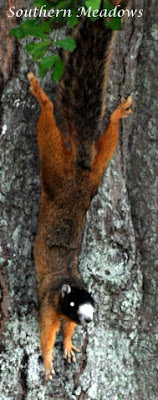As soon as March rolls around I make a habit of walking our woodland garden daily. The birds are singing high in the tree tops, the air smells of the earth and many ephemerals are beginning to poke up out of the leaf litter. It is a glorious time and this year we seem to be marching through spring at a rapid pace.
 |
| Packera aurea (Golden ragwort) in woodland garden |
The early risers are making the most of the sunlight that shines down through the open canopy. This is their time to bloom brightly before the trees leaf out and quiet things down. This time reminds me fondly of a story my mother read to me in German as a child
Etwas von den Wurzelkindern translated as
The Story of the Root Children
by Sibylle von Olfers, originally published in 1906. The root children
would sleep underground all winter until Mother Earth would awaken them
in spring and help them create colorful new clothes (an analogy for
spring flowers pushing up through the ground) and clean and paint the
beetles and bugs (preparing the pollinators to emerge). It is an enchanting story and the illustrations are fabulous. It captured my imagination and appealed to my love of nature.
 |
| My treasured childhood book, Etwas von den Wurzelkindern |
One of the first native blooms to emerge in our woodland garden is Sanguinaria canadensis or bloodroot. This impressive bloom is fleeting and must be rejoiced. It arises abruptly from the leaf litter like a candlestick aflame. The leaves wrapped snugly around the stalk akin to a mother protecting her child.
 |
| Sanguinaria canadensis emerging from leaf litter |
And then hurriedly it reveals its bright petals and anthers, attracting native bees (mining bees, sweat bees, small carpenter bees) and flies (bee fly). These industrious pollinators collect pollen but are not rewarded with any nectar. In years when we experience early warm weather, pollinators are in abundance; however, when pollinators are absent bloodroot is able to self-pollinate. In an act of self-preservation its anthers reach down gently and deposit pollen onto the stigma.
 |
| Sanguinaria canadensis in full bloom |
But, the story doesn't end there. When the pollinators have finished, ants step in. The seeds contain elaiosome, which attracts ants, who in turn carry the seeds to their nest where they eat part of the seed and discard the seed proper, remaining in the nest, a good growing medium.
 |
| Bloodroot sans petals, showing basel leaf |
The lovely Erythronium americnum (Eastern Trout Lily) is another
woodland wildflower that has recruited ants to assist in seed dispersal.
Ants eat the nutritious appendages attached to each seed and leave the
rest to germinate.
 |
| Erythronium americnum (Eastern Trout Lily) bloom |
Growing in colonies, the non-flowering individuals commonly outnumber the flowering ones. Even more reason to commemorate the elegant tulip-like flowers that rise up from green and purple mottled foliage. These lilies are a bright pop of color staged against the muted brown forest floor.
 |
| colony of Erythronium americnum (Eastern Trout Lily) |
The mighty Mayapple (Podophylum peltatum) also emerges in March in our garden. Its two large leaves resemble an umbrella when fully emerged. The flowers bloom later in spring and will be pollinated by bumble bees and other long-tongued bees. Box turtles will eat the berries and disperse the seeds on their journey.
 |
| Podophylum peltatum leaves unfolding |
Phlox divaricata (woodland phlox) is a little stunner that attracts a range of early pollinators including bumblebees, bee flies, butterflies (especially swallowtails), skippers, hummingbird clearwing moths and sphinx moths. Drawing such a spectrum of pollinators is worthy of celebration.
 |
| Phlox divaricata (woodland phlox) |
Dirca palustris (Leatherwood) is a woodland shrub which deserves a place in any wet/moist woodland setting, especially along pond and creek edges. The small, tubular, yellow flowers emerge first, promptly followed by the leaves, making it the first tree to unfold its leaves in our garden. Fruit that ripens in late spring/early summer is devoured by the birds. This underused native has fabulous bark which is tough and pliable and can be used in wilderness survival situations, so my boys tell me.
 |
| Dirca palustris (Leatherwood) |
These are fleeting moments in our garden, which require one to stop and contemplate the story each of these plants has to tell. Observing the relationships between these early ephemerals and the pollinators who service them is a site to behold. Pollinators must act quickly or they will miss the opportunity for this nutritious food. Even as I write this post, the tulip popular trees have already broken bud. Spring is anxious to arrive this year.
With this post I am joining Gardens Eye View's
Seasonal Celebrations. And next up I'll take a look at some
Lessons Learned this winter with Beth at Plant Postings.










.png)
